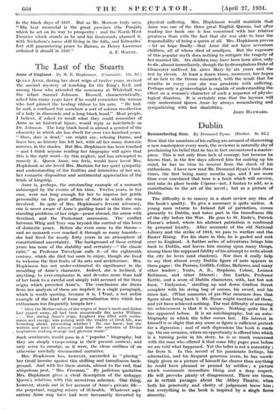The Last of the Stuarts
the ancient mystery of touching for the King's Evil, and among those who attended the ceremony at Whitehall was the infant Samuel Johnson. Boswell; characteristically, asked him many years later if he could remember the woman who had pinned the healing ribbon to his arm. " He had, he said, a confused but somehow a sort of solemn recollection of a lady in diamonds and a long black hood." Most people, I believe, if asked to recall what they could remember of Anne as an historical figure, would reply as indefinitely as Dr. Johnson. The long black hood is almost a symbol of the obscurity in which she has dwelt for over two hundred years.
" Shee, shee is dead," one might say, echoing. Donne, and leave her, as history has left her, with all her many domestic
sorrows, in the shades. But Mrs. Hopkinson has been touched —and I think anyone reading her biography will agree that this is the right word—by this neglect, and has attempted to remedy it.. Queen Anne, one feels, would have loved Mrs. Hopkinson as she loved Mrs. Masham for her quiet sympathy and understanding of the frailties and infirmities of her sex, her romantic disposition and sentimental appreciation of the trials of kingship.
Anne is, perhaps, the outstanding example of a monarch submerged by the events of his time. Twelve years, in her case, were not long enough for her to impress her gentle personality on the great affairs of State in which she was involved. In spite of Mrs. Hopkinson's fervent advocacy, one is never aware of Anne's guiding hand in the three out- standing problems of her reign—peace abroad, the union with Scotland, . and the Protestant succession. The conflict between Whig and Tory was beyond the control of this lover of domestic peace. Before she even came to the throne— and no monarch ever reached it through so many hazards— she had lived for nearly forty years in an atmosphere of constitutional uncertainty. The background of those critical years has none of the stability and certainty—" the classic calm," as Professor Trevelyan calls it—of the eighteenth century, which she died too soon to enjoy, though she lived
to welcome the first-fruits of its arts and architecture. Mrs. Hopkinson has not under-estimated its significance in the
moulding of Anne's character. Indeed, she is inclined, if anything, to over-emphasize it, and devotes more than half of her book to a careful and simply told account of the three reigns which preceded Anne's. The conclusions she draws from her analysis of them are implicit in a single paragraph, which is worth quoting, because it is, I trust, a not unfair example of the kind of loose generalization into which her enthusiasm too frequently tempts her : " After the Mediaevalism of the reigns of Anne's uncle and father had passed away, all had been unnaturally flat under William. . . . But, during Anne's reign, England was filled with enthu- siasm and energy, was pulsing with the vitality of fresh life, was bounding ahead, proceeding whither ? No one, knew, but the writers and men of science could hear the melodies of Divine inspiration making strange and glorious music."
• Such sentiments would pass in a " popular " biography, but they are simply exasperating in their present context, and only serve to smudge, as it were, the clean outlines of an otherwise carefully documented narrative.
Mrs. Hopkinson has, however, succeeded in " placing " her timid heroine against this shifting and tumultuous back- ground. And with her there stands, almost to the end, that ubiquitous pest, " Mrs. Freeman." By judicious quotation Mrs. Hopkinson gives a vivid description of the unhappy Queen's relations with this monstrous schemer, One thing, however, stands out in her account of Anne's private life— the perpetual, nagging misery of ill-health. Whatever aspi- rations Anne may have had were incessantly thwarted by physical suffering. Mrs. Hopkinson would maintain that Anne was one of the three great English Queens, but after reading her book one is less concerned with her relative' greatness than with the fact that she was able to bear the responsibility of being a queen at all. Mrs. Hopkinson proves —let us hope finally—that Anne did not have seventeen children, all of whom died of smallpox. But the exposuite of this popular myth does nothing to mitigate the tragedy of her married life. Six children may have been born alive, only: to die, almost immediately, though the hydrocephalous Duke of Gloucester outlived his sister Mary by six years and the rest by eleven. At least a dozen times, moreover, her hopes• of an heir to the throne miscarried, with the result that for months in every year she was prostrate with suffering. Perhaps only a gynaecologist is capable of understanding the effect on a woman's character of such a sequence of physio-. logical disasters. It is certainly true that the layman will only understand Queen Anne by always remembering and sympathizing with her disabilities.
JOHN HAYWARD,












































 Previous page
Previous page